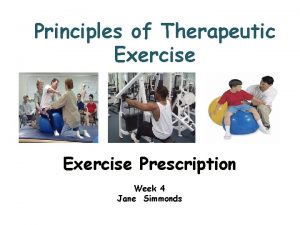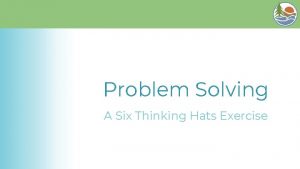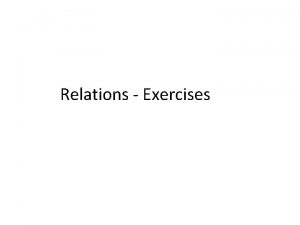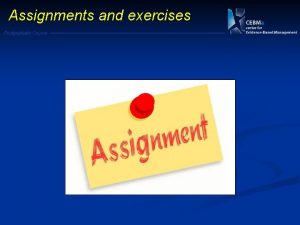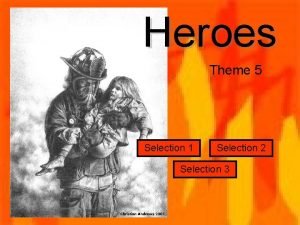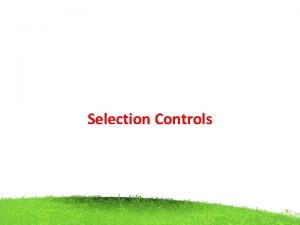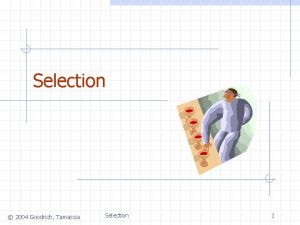A hierarchy for training Principles and Exercises selection























- Slides: 23

A hierarchy for training Principles and Exercises selection for optimising motor control, force capability and sport performance

Aim of this model Provide DOs/coaches/Contract S&C coaches a “How to” method for progressing athletes Provide a framework to encourage a focus on movement quality rather than load Provide basic principles of competency for each fundamental movement that are true for many variations Ensure athletes enter Pathway with a wide skill set of movements, rather than 1 -2 they have overemphasised

Hierarchy of movement progression Specificity Force Capability Variability – context, speed, fatigue, ROM, Planes of movement Motor Control – safe, stable skill

Hierarchy of movement progression Perform Load Stretch Learn

Stage 1: Motor Learning Aim: Movement Competency Fundamental movement/motor patterns Squat, Hinge, Push, Pull, Brace, Rotate, Jump/Land, Key coaching principles for each Constraints led approach Choose the best exercise to achieve the desired outcome (eg. goblet squat, overhead squat, back squat) learning/challenging/loading

Stage 2: Variability of Movement: Aim: Increase Bandwidth Stretch the bandwidth of the motor pattern Varying Contexts (eg. Symmetric Goblet, asymmetric goblet, front, back, overhead squad) Varying Speed (Tempo) Fatigue (eg. Increased volume, pre-fatigue, circuit) Coaching athlete to maintain principles regardless of context

Stage 3: Force Capability Aim: Increase Size/Speed/Strength Force = mass x acceleration Increase the force capabilities Strength-speed Speed-strength Speed Hypertrophy

Stage 4: Specificity Aim: Carryover to Sport Skills Contraction type Contraction angle Contraction range of motion Contraction speed Decision making Integration into sport skill (Special Strength training) Chaos

Principles of Squatting Key Principles: Squat to depth: hip crease below knee Heels flat Symmetry left to right Knees out (eg. No valgus/knock knees) Neutral Spine Balanced weight distribution

Example Skill: Squat Maximise Transfer Improve Load, Speed, Workload Interference: Varying types Control: Tempo, Bands, Asymmetry Fatigue: Volume, Circuit Demonstrate Key Principles Can we improve skill performance? Can we increase force? Are the principles stable in different conditions? Have we nailed the principles?

Example Skill: Squat Scrum Back Squat, Front Squat, Hex Bar Deadlift, Partial squat Can we improve skill performance? Can we increase force? Overhead Squat, Front Squat, Back Squat, Hex Bar Deadlift, Banded variation, Tempo Are the principles stable in different conditions? Goblet Squat Have we nailed the principles?

Principles of Hinging Key principles: Rotation at hip with neutral spinal posture (hips, shoulders, head) Soft knees Bar stays close to the body Braced trunk

Example Skill: Hinge Scrum setup, Rucking Barbell RDL, Barbell Deadlift, Olympic Lifting, Kettlebell Swing Single leg RDL, Kettlebell Swing, Dumbbell RDL, Barbell RDL, Deadlift, Banded Hinge Broomstick hinge/Banded hip hinge Can we improve skill performance? Can we increase force? Are the principles stable in different conditions? Have we nailed the principles?

Principles of Pushing Key Principles: Maintain neutral posture (hips, shoulders, head) Finish lift at full extension over crown of head (vertical) or over chest (horizontal) Elbows at 45 degrees (horizontal) Trunk/glutes braced

Example Skill: Horizonal push Hand Off Bench Throw, Med ball throw, Bench Press Can we improve skill performance? Can we increase force? DB Bench, Incline bench, Bench Press Weighted Press Up, Landmine Press Are the principles stable in different conditions? Box Press Up Have we nailed the principles?

Example Skill: Vertical push Line Out lift Military Press, Push Press, Jerk Can we improve skill performance? Can we increase force? BUKB Press, Landmine Press, DB Military press, Military Press, Kettlebell Press, Incline Db Press Are the principles stable in different conditions? Kettlebell press Have we nailed the principles?

Principles of Pulling Key Principles: Maintain neutral posture (hips, shoulders, head) Full Range of motion at arms Elbows at 45 degrees (horizontal pulling) Trunk/glutes braced

Example Skill: Horizontal pull Tackle, Drag, Clinch BB Row, Bench Pull, Pendlay Row, Seated Row, Can we improve skill performance? Can we increase force? Renegade row, DB Row, Supine TRX/Ring/Barbell row, BB Row, Pendlay Row Seated row, Chest Supported Row Are the principles stable in different conditions? 45 deg Bodyweight Row Have we nailed the principles?

Example Skill: Vertical pull Tackle, Drag, Clinch Chin Up, Pull up, Wide Grip Pull up Can we improve skill performance? Can we increase force? Lat Pulldown (Vary grip), SA Pulldown, 45 deg Sa Pulldown, Chin Up, Pull up, Wide Grip Pull Up Are the principles stable in different conditions? Lat Pulldown/ Band Assisted Pullup or Chin Up Have we nailed the principles?

Principles of Bracing Key Principles: Neutral spinal posture (Hips, Shoulders, head) Slight posterior tilt of pelvis (glutes braced) Abdominal bracing

Example Skill: Brace Scrum/Ruck Rollout, Weighted plank, Leg raises, Leg Lower, (Upper body pushing/pulling variants) Can we improve skill performance? Can we increase force? SB plank/side Plank, Rollout, Press Up, Shoulder taps, Leg Lifts, , Bird dog, L-sit, Bear Crawl, Pallof press Are the principles stable in different conditions? Plank/Side Plank Have we nailed the principles?

Principles of Jumping/Landing Key Principles: Correct use of arms Full extension at take off Soft, flat footed, balanced landing Cushioning through knees and hips Knees remaining in line with feet, minimal lateral/knock knee movement Maintain neutral spinal posture (hips, shoulders, head)

Example Skill: Jump/Land Acceleration, Cutting, Jumping Bounding, Depth Jumps, Resisted Jumps Can we improve skill performance? Can we increase force? Multi-direction jumps/hops & stick, varying hurdle heights/directions Are the principles stable in different conditions? Jump/Hop and stick Have we nailed the principles?
 Two way selection and multiway selection
Two way selection and multiway selection Multiway selection in c
Multiway selection in c Mass selection
Mass selection Balancing selection vs stabilizing selection
Balancing selection vs stabilizing selection Similarities
Similarities K selection r selection
K selection r selection Natural selection vs artificial selection
Natural selection vs artificial selection Difference between continuous and discontinuous variation
Difference between continuous and discontinuous variation Disruption selection
Disruption selection Logistic model of population growth
Logistic model of population growth Natural selection vs artificial selection
Natural selection vs artificial selection Jcats wargame simulation
Jcats wargame simulation Principles of therapeutic exercises
Principles of therapeutic exercises Problem solving hats
Problem solving hats Iso 22301 utbildning
Iso 22301 utbildning Typiska drag för en novell
Typiska drag för en novell Nationell inriktning för artificiell intelligens
Nationell inriktning för artificiell intelligens Ekologiskt fotavtryck
Ekologiskt fotavtryck Varför kallas perioden 1918-1939 för mellankrigstiden?
Varför kallas perioden 1918-1939 för mellankrigstiden? En lathund för arbete med kontinuitetshantering
En lathund för arbete med kontinuitetshantering Adressändring ideell förening
Adressändring ideell förening Personlig tidbok fylla i
Personlig tidbok fylla i A gastrica
A gastrica Förklara densitet för barn
Förklara densitet för barn












